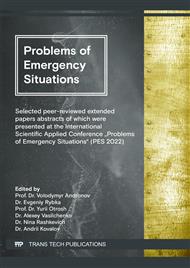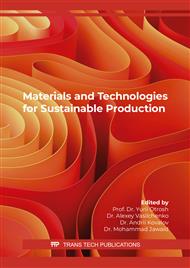[1]
R.Q. Puchol, E.R. Sosa, L.O. Gonzalez, Y.P. Castaneda, L.Y. Sierra, New conception of the reutilization of solid waste from Cuban nickeliferous hydrometallurgical industry, Centro Azucar. 43, 4 (2016) 1–15.
Google Scholar
[2]
I. Pincovschi, N. Neacsu, C. Modrogan, The Adsorbtion of Lead, Copper, Chrome and Nickel Ions from Waste Waters in Agricultural Argilaceous Soils, Revista de Chimie. 68, 4 (2017) 635–638.
DOI: 10.37358/rc.17.4.5520
Google Scholar
[3]
V. Madebwe, C. Madebwe, A. Munodawafa, F. Mugabe, Analysis of the Spatial and Temporal Variability of Toxic Heavy Metal Concentrations in Ground Water Resources in Upper Sanyati Catchment, Midlands Province, Zimbabwe, IIARD International Journal of Geography and Environmental Management. 3, 1 (2017) 23–37.
DOI: 10.4314/ejesm.v8i5.9
Google Scholar
[4]
I. Rubezhniak, Assessment of Standards of Heavy Metals Contaminated Soils in Ukraine and the EU Countries, Scientific Bulletin of the National University of Life and Environmental Sciences of Ukraine, Series: Biology, Biotechnology, Ecology. 234 (2016) 228–238.
Google Scholar
[5]
D.A. Eastmond, J.T. MacGregor, R.S. Slesinski, Trivalent Chromium: Assessing the Genotoxic Risk of an Essential Trace Element and Widely Used Human and Animal Nutritional Supplement, Critical Reviews in Toxicology. 38, 3 (2008) 173–190.
DOI: 10.1080/10408440701845401
Google Scholar
[6]
N. Itankar, Y. Patil, Management of Hexavalent Chromium from Industrial Waste Using Low-cost Waste Biomass, Procedia – Social and Behavioral Sciences. 133, 5 (2014) 219–224.
DOI: 10.1016/j.sbspro.2014.04.187
Google Scholar
[7]
Y. Chervona, A. Arita, M. Costa, Carcinogenic metals and the epigenome: understanding the effect of nickel, arsenic, and chromium, Metallomics. 4, 7 (2012) 619–627.
DOI: 10.1039/c2mt20033c
Google Scholar
[8]
I. Atanassov, New bulgarian soil pollution standards, Bulgarian Journal of Agricultural Science. 14 (2008) 68–75.
Google Scholar
[9]
M.L.C.M. Henckens, E.C. Van Ierland, P.P.J. Driessen, E. Worrell, Mineral resources: Geological scarcity, market price trends, and future generations, Resources Policy. 49 (2016) 102–111.
DOI: 10.1016/j.resourpol.2016.04.012
Google Scholar
[10]
V. Borysov, A. Lytvynov, N. Braginets, A. Petryshchev, S. Artemev, B. Tsymbal, A. Poliakov, V. Bratishko, V. Kuzmenko, O. Kholodiuk, Features of the phase and structural transformations in the processing of industrial waste from the production of high-alloyed steels, Eastern-European Journal of Enterprise Technologies. 3, 10(105) (2020) 48–54.
DOI: 10.15587/1729-4061.2020.205779
Google Scholar
[11]
A. Petryshchev, N. Braginec, V. Borysov, V. Bratishko, O. Torubara, B. Tsymbal, S. Borysova, S. Lupinovich, A. Poliakov, V. Kuzmenko, Study into the structural-phase transformations accompanying the resource-saving technology of metallurgical waste processing, Eastern-European Journal of Enterprise Technologies. 4, 12(100) (2019) 37–42.
DOI: 10.15587/1729-4061.2019.175914
Google Scholar
[12]
S. Mechachti, O. Benchiheub, S. Serrai, M. Shalabi, Preparation of iron Powders by Reduction of Rolling Mill Scale, International Journal of Scientific & Engineering Research. 4, 5 (2013) 1467–1472.
Google Scholar
[13]
S. M. Grigor'ev, A. S. Petrishchev, Assessing the Phase and Structural Features of the Scale on P6M5Ф3 and P12M3K5Ф2 Steel, Steel in Translation. 42, 3 (2012) 272–275.
DOI: 10.3103/s0967091212030059
Google Scholar
[14]
A. Petryshchev, D. Milko, V. Borysov, B. Tsymbal, I. Hevko, S. Borysova, A. Semenchuk, Studying the physical-chemical transformations at resource-saving reduction melting of chrome-nickel-containing metallurgical waste, Eastern-European Journal of Enterprise Technologies. 2, 12(98) (2019) 59–64.
DOI: 10.15587/1729-4061.2019.160755
Google Scholar
[15]
V. Volokh, E. Kim, T. Fesenko, A. Petryshchev, S. Artemev, B. Tsymbal, L. Makarenko, A. Hedzyk, V. Slabko, V. Khmelovskyi, Identifying the features of structural and phase transformations in processing the waste of metallurgical products doped with refractory elements, Eastern-European Journal of Enterprise Technologies. 5, 12(107) (2020) 32–38.
DOI: 10.15587/1729-4061.2020.214826
Google Scholar
[16]
A. Poliakov, A. Dzyuba, V. Volokh, A. Petryshchev, B. Tsymbal, M. Yamshinskij, I. Lukianenko, A. Andreev, T. Bilko, V. Rebenko, Identification of patterns in the structural and phase composition of the doping alloy derived from metallurgical waste processing, Eastern-European Journal of Enterprise Technologies. 2, 12(110) (2021) 38–43.
DOI: 10.15587/1729-4061.2021.230078
Google Scholar
[17]
H.Y. Zhu, Z.B. Li, H.S. Yang, L.G. Luo, Carbothermic Reduction of MoO3 for Direct Alloying Process, Journal of Iron and Steel Research, International. 20, 10 (2013) 51–56.
DOI: 10.1016/s1006-706x(13)60176-4
Google Scholar
[18]
G.P. Shveikin, N. A. Kedin, Products of carbothermal reduction of tungsten oxides in argon flow, Russian Journal of Inorganic Chemistry. 59, 3 (2014) 153–158.
DOI: 10.1134/s0036023614030206
Google Scholar
[19]
V. Ryndiaiev, O. Kholodiuk, V. Khmelovskyi, A. Petryshchev, A. Yushchenko, G. Fesenko, Y. Chaplyhin, V. Strelnikov, A. Andreev, V. Matukhno, Establishing patterns of the structural-phase transformations during the reduction of tungstencontaining ore concentrate with carbon, Eastern-European Journal of Enterprise Technologies. 1, 12(109) (2021) 16–21.
DOI: 10.15587/1729-4061.2021.225389
Google Scholar
[20]
L. Zhao, L. Wang, D. Chen, H. Zhao, Y. Liu, T. Qi, Behaviors of vanadium and chromium in coal-based direct reduction of high-chromium vanadium-bearing titanomagnetite concentrates followed by magnetic separation, Transactions of Nonferrous Metals Society of China. 25, 4 (2015) 1325–1333.
DOI: 10.1016/s1003-6326(15)63731-1
Google Scholar
[21]
I. V. Ryabchikov, B. F. Belov, V. G. Mizin, Reactions of metal oxides with carbon, Steel in Translation. 44, 5 (2014) 368–373.
DOI: 10.3103/s0967091214050118
Google Scholar
[22]
Y. Zhang, W. Wei, X. Yang, F. Wei, Reduction of Fe and Ni in Fe–Ni–O systems, Journal of Mining and Metallurgy, Section B: Metallurgy. 49, 1 (2013) 13–20.
DOI: 10.2298/jmmb120208038z
Google Scholar



